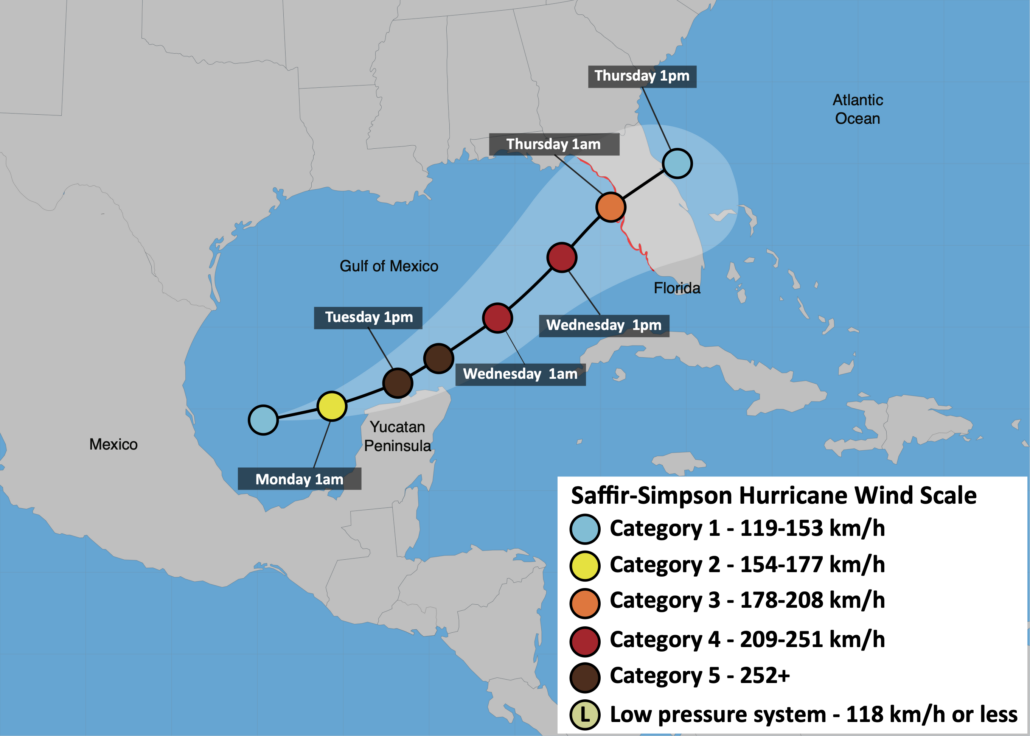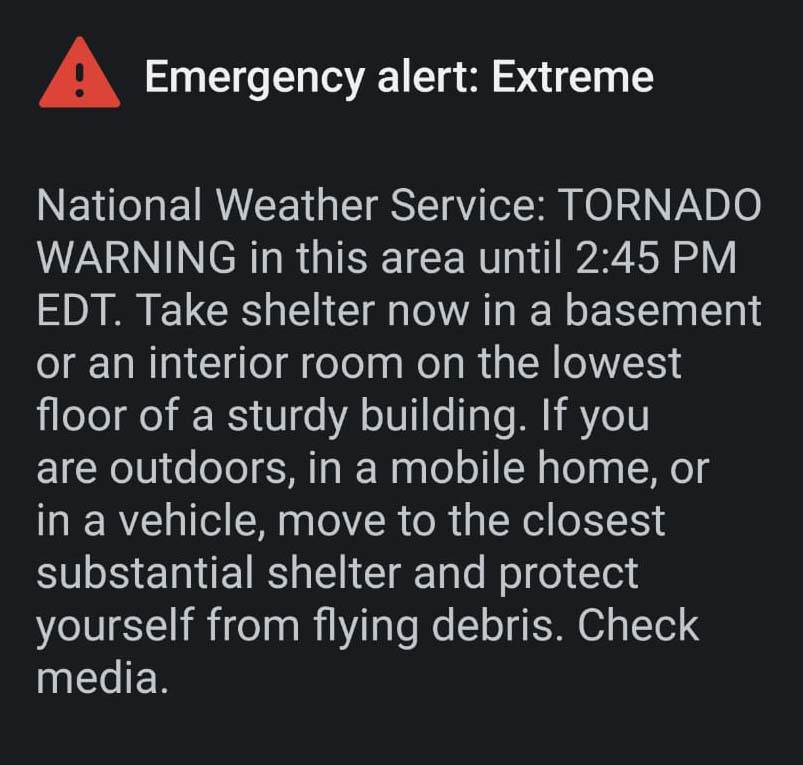Hurricane Milton: Formation and Path
Hurricane Milton formed as a tropical depression over the warm waters of the Gulf of Mexico in early October 2024. It rapidly intensified to a Category 5 hurricane, with maximum sustained winds reaching 180 mph. The storm initially moved northeast, skirting the northern coast of the Yucatan Peninsula before accelerating across the Gulf of Mexico. On October 9th at approximately 8:30 p.m. Eastern Time, Hurricane Milton made landfall near Siesta Key in Sarasota County, Florida, as a Category 3 storm with winds up to 120 mph. The storm then moved across central Florida, causing widespread damage before exiting into the Atlantic Ocean.
The path of Hurricane Milton
Causes of Hurricane Milton
Hurricane Milton began as a tropical depression in the warm waters of the Gulf of Mexico. These unusually warm waters helped Milton grow stronger very quickly. Hurricanes are powered by warm ocean water and moist air. The warmer the water, the more energy a hurricane can gather, which explains why Milton intensified from a small storm to a powerful hurricane in just 48 hours.
Climate change is also thought to have played a role. Warmer ocean temperatures caused by climate change made the water in the Gulf of Mexico much warmer than normal, giving Hurricane Milton extra power to intensity quickly and become dangerous.
Did you know?
Hurricane Milton intensified from a tropical depression to a Category 5 hurricane in just 48 hours, making it one of the fastest-growing storms in Atlantic history. This rapid intensification was fueled by record-breaking sea temperatures in the Gulf of Mexico, which were at their highest levels ever recorded.
Primary Effects
The primary effects of Hurricane Milton were devastating. It brought extremely strong winds, reaching up to 165 mph (270 km/h), as well as heavy rainfall and storm surges. Storm surges occur when strong winds push ocean water onto land, causing coastal flooding. In some areas, houses and buildings were flooded, roofs were torn off, and power lines were brought down, leaving many communities without electricity. Hurricane Milton resulted in a total of 30 fatalities, with three deaths in Mexico and 27 in the USA, and seven people still reported missing in Mexico. The death toll is expected to rise as authorities continue to assess the damage.
Hurricane Milton landed at Siesta Key, just south of Tampa, and caused significant flooding, especially in Sarasota County, where storm surges reached 8-10 feet (2.5-3 meters). Plant City, just inland from Tampa, received more than 13 inches (33 cm) of rain, leading to widespread flooding.
The estimated cost of Hurricane Milton’s damage is now around $50 billion, including destruction to homes, infrastructure, and businesses across Florida. The storm also caused extensive damage, such as wrecking an estimated 150 homes, knocking out power to more than 3.3 million people, and toppling a 500-foot construction crane.
Secondary Effects
The secondary effects of Hurricane Milton included long-term disruptions to daily life and health risks. Many people lost their homes, and communities faced shortages of clean water and food because of the damage to stores and infrastructure. Floodwaters also posed health risks as they carried harmful bacteria and chemicals.
Another major problem was the power outages. The storm knocked out power across large parts of Florida, leaving millions without electricity for days. This made it difficult for emergency responders to help people and affected hospitals and other important services. About 1.5 million people were still without power days after the storm, and many roads and bridges were damaged, making travel dangerous.
Tornadoes also added to the destruction. There were more than 140 tornado warnings across Florida, and some tornadoes caused significant damage. In St. Lucie County, a tornado struck a retirement home, leading to five confirmed deaths. Tornadoes also killed other residents, including a woman in Tampa and two women in Volusia County.
Fuel shortages were also reported, with about 73% of gas (petrol) stations in the Tampa and St. Petersburg area running out of fuel, making it challenging for residents to evacuate or return home. Thousands of evacuees faced difficulties returning home, including long traffic jams and lengthy waits for petrol. Florida set up three fuel distribution sites in Bradenton, Plant City, and St. Petersburg, where residents could get 10 gallons of petrol for free, with more sites planned to help meet demand.
Immediate Responses
In response to Hurricane Milton, authorities issued mandatory evacuation orders for many areas before the storm arrived. This was a very important step that saved many lives. Officials from the Federal Emergency Management Agency (FEMA) and local emergency services worked together to provide shelter, food, and medical aid to those affected by the storm.
News broadcasts and emergency text messages, including tornado alerts, warned people about the storm. These warnings helped residents understand the severity of the approaching hurricane and the need for immediate action. The effective use of multiple communication channels ensured that many people received timely information, prompting widespread evacuations that undoubtedly saved lives.
Tornado text alert during Hurricane Milton
Urban Search and Rescue Teams and the Florida National Guard have played a major role in rescue operations. According to Governor Ron DeSantis, these teams rescued 1,000 people and 105 animals. Rescue operations are ongoing, with urban search and rescue teams conducting door-to-door searches across affected areas. Large vehicles, boats, and helicopters have been deployed across Florida to locate people in need of assistance.
There are 23 Urban Search and Rescue Teams consisting of more than 1,600 people and 10 Swift Water Teams specialised in conducting rescues in fast-moving waters. The Florida National Guard has deployed over 6,500 members to assist in rescue efforts, and an additional 2,500 personnel are expected to arrive from other states.
One significant rescue effort involved saving around 400 people from a flooded apartment building in Pinellas County. Additionally, the Florida Coast Guard rescued a fishing boat captain who was found floating 30 miles out in the Gulf of Mexico on a cool box. He was safely brought back to shore by helicopter.
Volunteers have also contributed to relief efforts by distributing hot meals to affected individuals, and singer Taylor Swift donated $5 million to aid in the recovery process.
After the storm, emergency teams worked hard to clear debris from roads and restore power as quickly as possible. NASA also helped by using special radar systems that can see through clouds to help emergency responders understand the flooding situation and where the most help was needed.
President Joe Biden emphasised the importance of staying indoors and avoiding dangerous areas, as downed power lines and road washouts created hazardous conditions. Federal aid has been deployed to support the recovery efforts. However, challenges remain, especially as Florida was still recovering from Hurricane Helene, which struck just weeks earlier and caused significant damage.
Biden also announced that he would request additional disaster assistance funding from Congress, as the cost of dealing with both Milton and Helene could exceed current resources. Biden praised the efforts of emergency responders and thanked local officials for their cooperation.
Florida Governor Ron DeSantis stated that the state’s response efforts had been well-coordinated with federal support. He also announced additional fuel distribution sites to help alleviate fuel shortages and mentioned that power restoration efforts were underway, which would help normalise fuel availability.
In Punta Gorda, Mayor Lynne Matthews noted that fewer people needed rescue than Hurricane Helene, largely due to effective evacuation measures and increased public awareness.
After the storm, emergency teams worked hard to clear debris from roads and restore power as quickly as possible. NASA also helped by using special radar systems that can see through clouds to help emergency responders understand the flooding situation and where the most help was needed.
In Punta Gorda, Mayor Lynne Matthews noted that fewer people needed rescue than Hurricane Helene, largely due to effective evacuation measures and increased public awareness.



